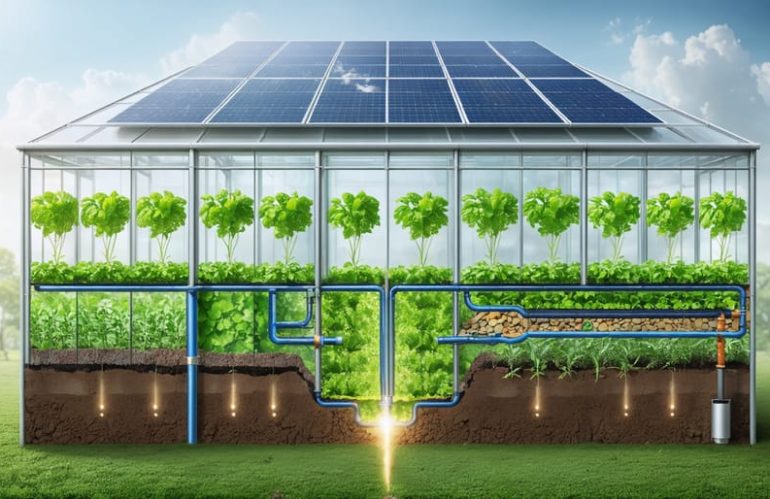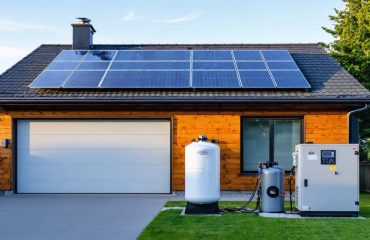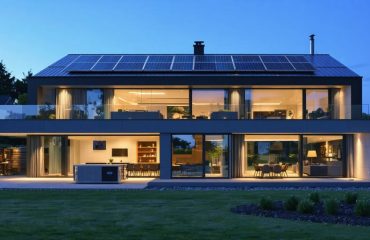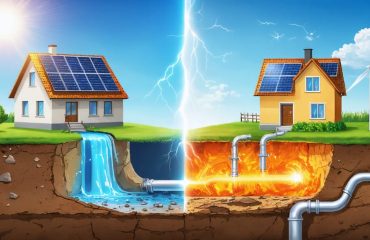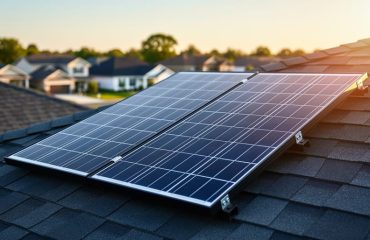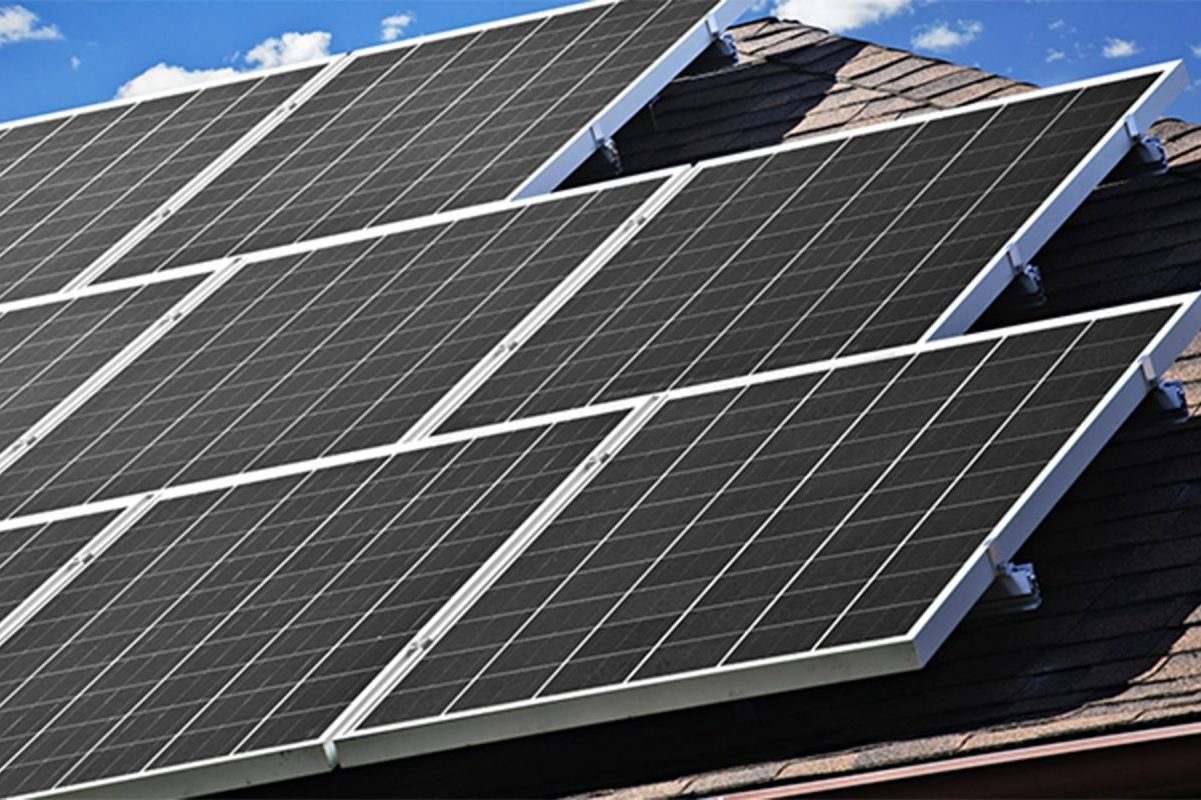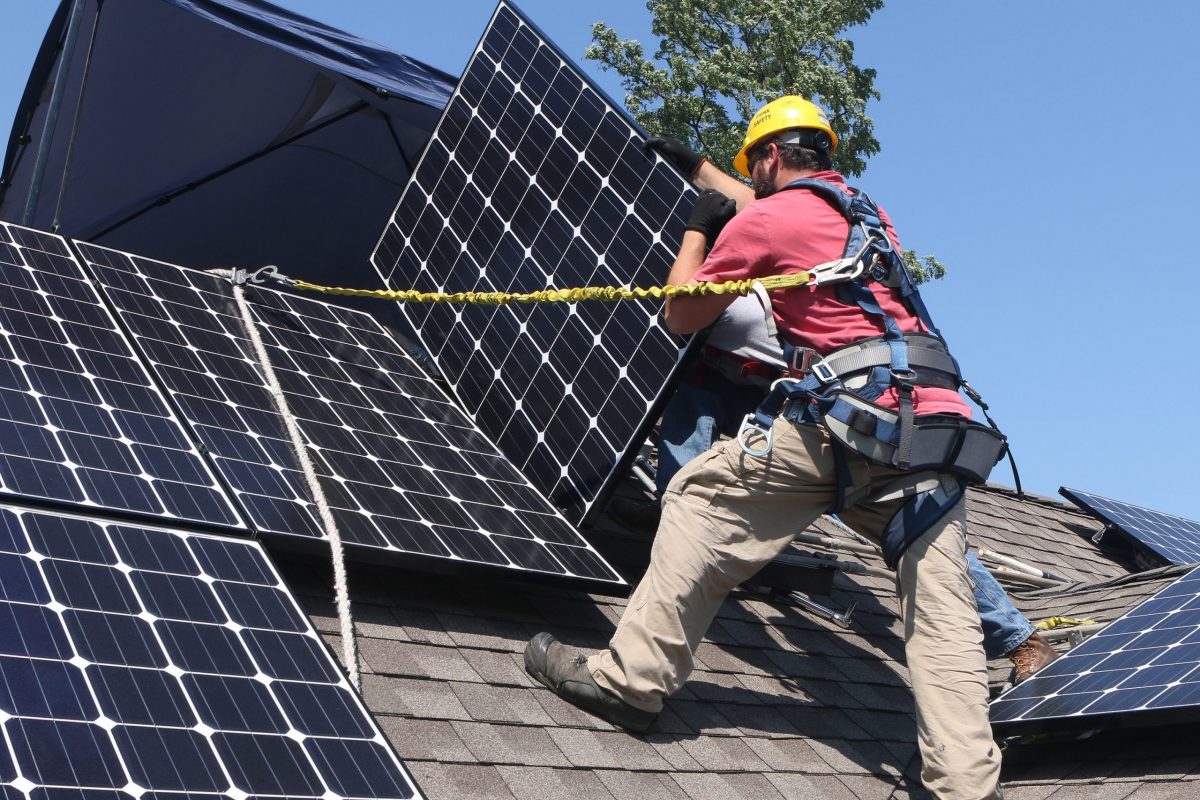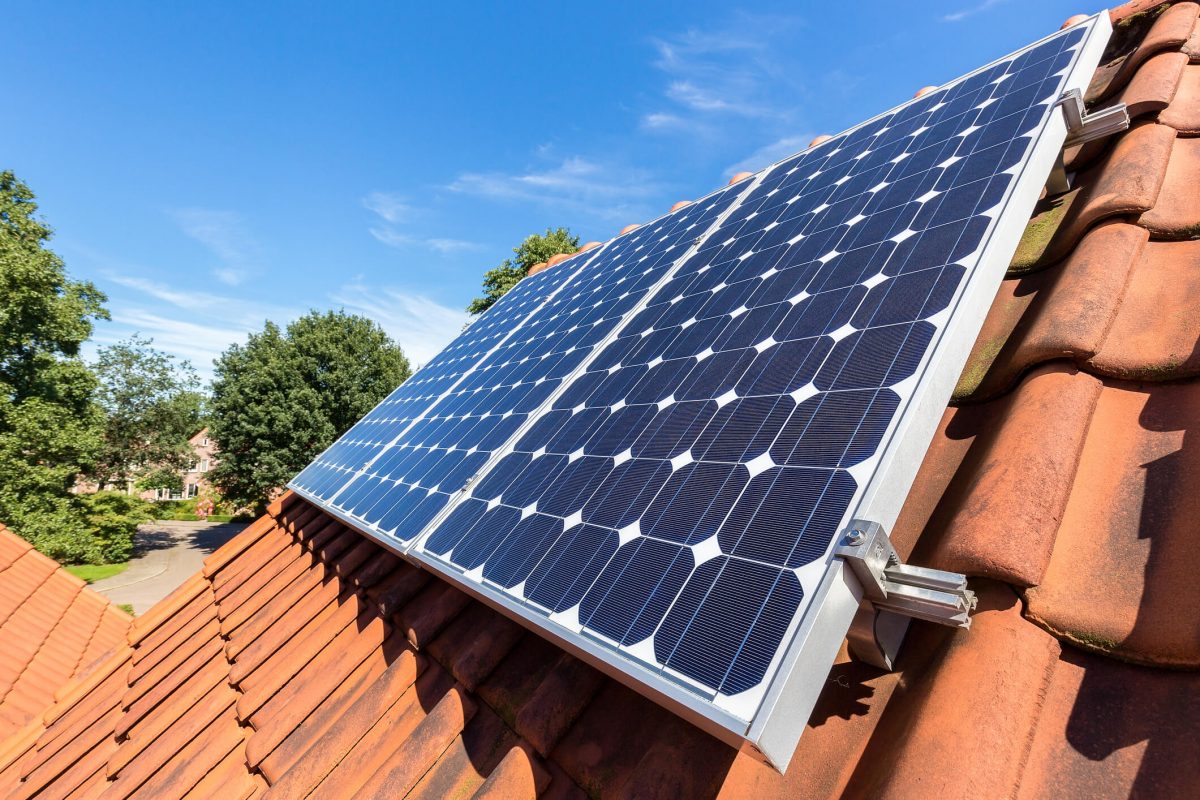Harness the Earth’s constant underground temperature to revolutionize greenhouse heating while slashing energy costs by up to 70%. Modern solar-geothermal hybrid systems transform traditional greenhouse operations into year-round growing powerhouses, maintaining optimal temperatures even in the harshest winters. By tapping into geothermal energy just 6-8 feet below the surface, these systems provide consistent heat at 50-60°F (10-15°C), creating perfect growing conditions while significantly reducing environmental impact. Whether you’re a home gardener or commercial grower, geothermal heating offers a sustainable solution that pays for itself through reduced operating costs and extended growing seasons. The combination of ground-source heat pumps with existing greenhouse structures requires minimal modification while delivering maximum efficiency – making it an increasingly popular choice for forward-thinking growers who want to maximize productivity while minimizing their carbon footprint.
How Geothermal Heating Works in Greenhouses
Ground Source Heat Exchange Basics
The beauty of a ground source heat exchange system lies in its simple yet effective approach to heating. Just a few feet below the Earth’s surface, the ground maintains a fairly constant temperature year-round, typically between 50-60°F (10-15°C). This natural heat reservoir can be tapped into using a network of underground pipes filled with a water-based solution.
These pipes, often called ground loops, circulate the solution through the warm earth, absorbing its heat along the way. As the fluid travels through the system, a heat pump extracts this thermal energy and concentrates it to provide warming for your greenhouse. Think of it like a solar panel that works with the Earth’s heat instead of sunlight.
The system works continuously, regardless of weather conditions or time of day, making it an incredibly reliable heating source for maintaining optimal growing temperatures in your greenhouse. Best of all, this process uses very little electricity, mainly just to power the circulation pump and heat exchanger.
Underground Loop Systems
Underground loop systems come in three main configurations, each offering unique advantages for greenhouse heating. Horizontal loops are the most common choice, installed in trenches about 6-8 feet deep. These systems work well for properties with ample land space and are typically the most cost-effective option.
For locations with limited horizontal space, vertical loops provide an excellent alternative. These systems extend 100-400 feet underground and require less surface area, making them ideal for smaller properties. While initially more expensive to install, vertical loops deliver consistent performance year-round.
Pond or lake loops offer a third option when a water source is available nearby. These systems use coiled pipes submerged in water, taking advantage of stable water temperatures. They’re often the most economical to install and highly efficient, though they require proper water depth and quality to function optimally.
Each configuration can be customized to match your greenhouse’s specific heating needs and site conditions. The key is choosing a layout that balances installation costs with long-term performance and available space.
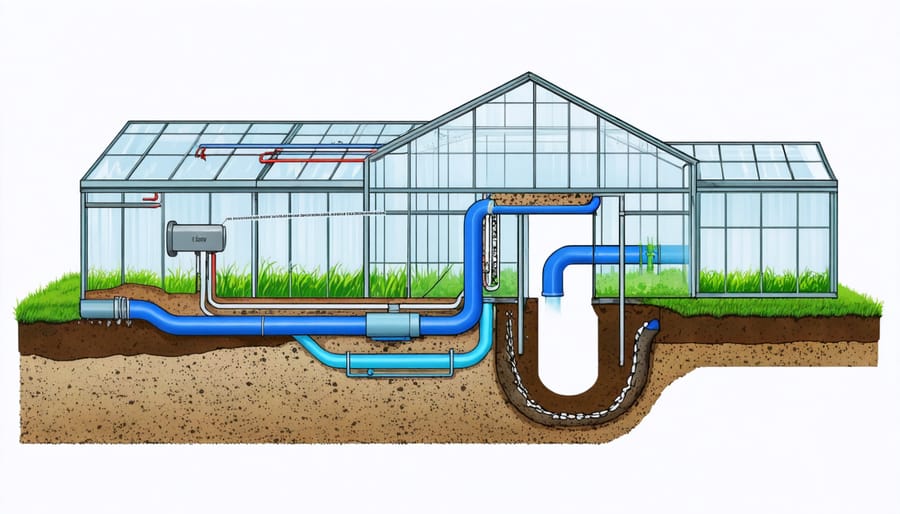
Solar Integration: The Perfect Partnership
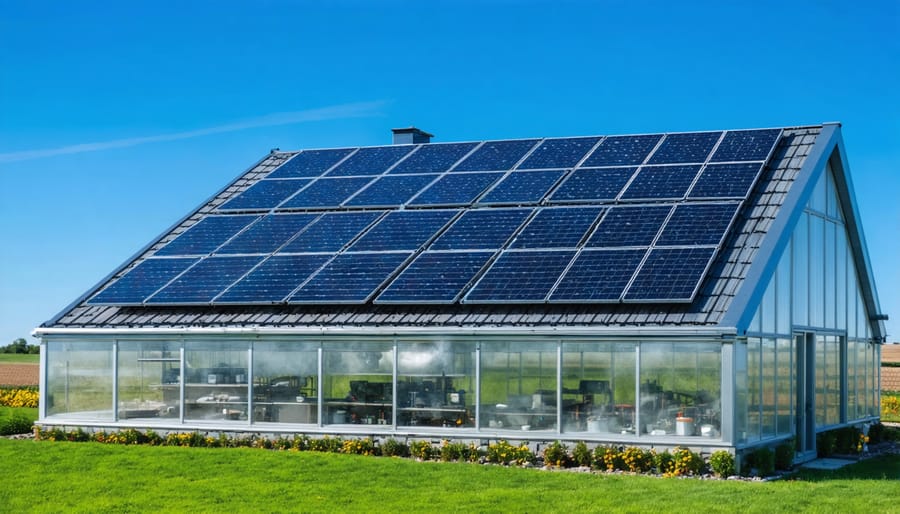
Powering Your Heat Pump
Modern geothermal heating systems for greenhouses can be efficiently powered through solar energy, creating a truly sustainable heating solution. Integrating solar with geothermal systems offers a powerful combination that reduces operational costs while maximizing environmental benefits.
Solar panels convert sunlight into electricity to power the heat pump’s compressor and circulation system. During peak daylight hours, excess solar energy can be stored in batteries or fed back into the grid, providing credits for nighttime operation. This setup ensures your greenhouse maintains optimal temperatures around the clock while minimizing reliance on traditional power sources.
The beauty of this combination lies in its complementary nature. While geothermal provides consistent base heating by tapping into the earth’s stable temperatures, solar panels offset the system’s electrical demands. In many cases, the solar array can generate enough power to run the entire geothermal system during sunny days, making your greenhouse operation nearly energy-independent.
For maximum efficiency, smart controllers can be installed to automatically adjust the system based on available solar power, greenhouse temperature requirements, and time of day. This intelligent management ensures your plants receive consistent warmth while optimizing energy usage and reducing utility bills.
Backup Heating Solutions
While geothermal heating systems provide reliable year-round temperature control for your greenhouse, incorporating solar thermal as a backup heating solution can enhance efficiency and provide additional benefits. Solar thermal collectors mounted on your greenhouse roof or nearby structures can capture sunlight during the day, converting it into heat that’s stored in a thermal mass system, typically consisting of water tanks or a rock bed.
These backup systems work seamlessly with your geothermal setup, activating automatically when additional heating is needed, such as during particularly cold nights or extended cloudy periods. The stored solar energy can be released gradually, helping maintain optimal growing temperatures while reducing the workload on your geothermal system.
The beauty of combining solar thermal with geothermal heating lies in its sustainability and cost-effectiveness. Since both systems harness natural energy sources, you’ll enjoy minimal operating costs while maintaining a smaller environmental footprint. Solar thermal backup systems are especially valuable during peak winter months when heating demands are highest.
To maximize efficiency, consider installing thermal screens or curtains that can be drawn at night to retain the heat collected during the day. This simple addition can significantly reduce heat loss and improve the overall performance of your hybrid heating system, ensuring your greenhouse stays at the perfect temperature year-round while keeping energy costs in check.
Real Cost Savings for Your Greenhouse
Initial Investment vs. Long-term Returns
While the upfront cost of a geothermal heating system for your greenhouse typically ranges from $15,000 to $30,000, the long-term benefits make it a smart investment. Most greenhouse owners see a return on their investment within 5-7 years through reduced energy costs, with savings of 50-70% on heating bills compared to traditional systems.
The initial investment covers ground loop installation, heat pump equipment, and system setup. However, many states offer tax incentives and rebates that can reduce these costs by 20-30%. When combined with annual energy savings of $1,500-$3,000, depending on greenhouse size and local climate, the system essentially pays for itself.
What’s particularly appealing is the system’s 20-25 year lifespan, with minimal maintenance requirements. After the payback period, you’ll enjoy over 15 years of reduced operating costs. Factor in rising energy prices, and the long-term savings become even more significant. Plus, these systems can increase your property value by up to 7%, making them an attractive investment for the future.
Available Incentives and Rebates
Several financial incentives can make geothermal greenhouse heating systems more affordable. The Federal Investment Tax Credit (ITC) allows you to claim up to 30% of your system’s installation costs on your taxes. Many states offer additional tax credits, ranging from $1,000 to $10,000, while some utility companies provide rebates between $500 and $2,500 for geothermal installations.
Rural greenhouse operators may qualify for USDA REAP grants, covering up to 25% of project costs. The Environmental Quality Incentives Program (EQIP) also offers financial assistance specifically for agricultural operations implementing energy-efficient solutions.
Local energy cooperatives frequently run energy-efficiency programs with cash incentives for geothermal installations. Some municipalities offer property tax exemptions for renewable energy improvements, while others provide low-interest financing options through green energy loans.
Remember to check with your local energy office, as available incentives vary by location and change periodically. Working with a qualified installer can help identify all applicable rebates and assist with the application process.
Installation and Maintenance Made Simple
Planning Your System
Before installing a geothermal heating system for your greenhouse, careful planning is essential to ensure optimal performance and efficiency. Start by assessing your greenhouse’s size and heating requirements. A general rule of thumb is to calculate 10-15 BTUs per square foot of growing space, though this may vary based on your climate zone and the types of plants you’re growing.
Consider your local geology and available space. The system’s ground loops can be installed horizontally if you have sufficient land area, or vertically if space is limited. Soil composition plays a crucial role – dense, moist soils generally transfer heat better than loose, dry soils.
Your greenhouse’s insulation quality significantly impacts system sizing. Well-insulated structures require less heating capacity, potentially reducing your initial investment. Consider upgrading insulation before finalizing your system design.
Water availability is another key factor, as some systems require a reliable water source. If you’re considering a hybrid system installation with solar panels, evaluate your greenhouse’s sun exposure and roof orientation.
Don’t forget to check local building codes and permit requirements. Many jurisdictions have specific regulations for geothermal installations. Working with a qualified contractor who can help navigate these requirements while properly sizing your system is crucial for long-term success.
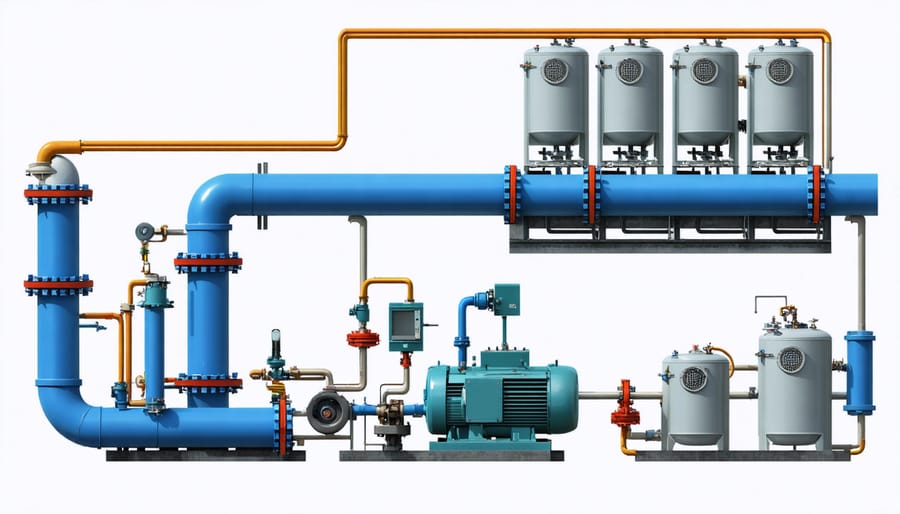
Ongoing Care Tips
Regular maintenance of your greenhouse’s geothermal heating system ensures optimal performance and longevity. Start with monthly visual inspections of all visible components, including pipes, connections, and heat exchangers. Check for any signs of leaks, corrosion, or unusual noises during operation.
Clean or replace air filters every three months to maintain proper airflow and system efficiency. The heat pump’s coils should be cleaned annually to remove dust and debris that can reduce heat transfer efficiency. Monitor the system’s pressure gauges regularly – unusual readings might indicate potential issues that need professional attention.
Keep the area around outdoor components clear of vegetation and debris. During winter, ensure snow doesn’t block airflow to external units. Inside the greenhouse, regularly inspect the distribution pipes for any signs of damage or wear.
Test the system’s temperature controls monthly to ensure accurate readings and proper function. Consider maintaining a log of system performance, including temperature readings and energy consumption. This data helps identify potential issues early and track system efficiency over time.
Schedule professional maintenance annually, ideally before the peak heating season. A qualified technician can perform detailed inspections, test refrigerant levels, and calibrate the system for optimal performance. They can also identify and address minor issues before they become major problems.
Geothermal heating systems represent a game-changing solution for greenhouse operations, offering a perfect blend of environmental responsibility and economic sensibility. By tapping into the Earth’s constant underground temperatures, these systems provide reliable, sustainable heating that can dramatically reduce both energy costs and carbon footprint. The initial investment in geothermal technology, while significant, typically pays for itself through energy savings within 5-10 years, making it an attractive long-term investment for greenhouse owners.
The benefits extend far beyond just cost savings. With consistent temperatures year-round, plants thrive in the stable environment that geothermal systems provide. This reliability translates to extended growing seasons, increased crop yields, and the ability to grow a wider variety of plants regardless of external weather conditions. Additionally, the reduced reliance on fossil fuels means greenhouse operators can market their produce as environmentally sustainable, meeting growing consumer demand for eco-friendly products.
Now is the perfect time to consider implementing a geothermal heating system in your greenhouse. With advancing technology, increasing energy costs, and various government incentives available, the barriers to entry are lower than ever. By making the switch to geothermal heating, you’re not just investing in your greenhouse’s future – you’re contributing to a more sustainable agricultural practice that benefits both your bottom line and the planet. Take the first step today by consulting with a geothermal specialist to explore how this technology can transform your greenhouse operation.

